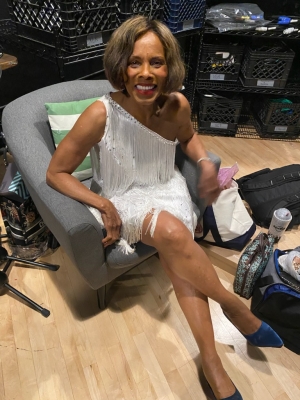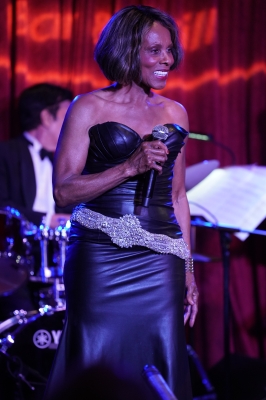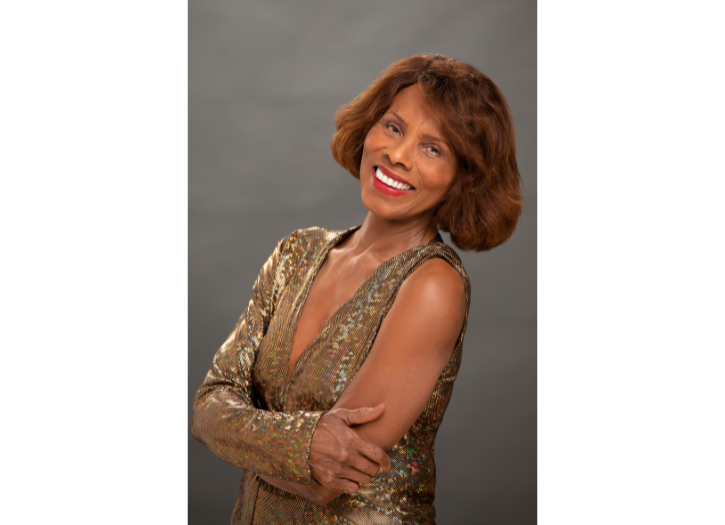Recently, I had the privilege of interviewing the iconic Gloria Hendry, a trailblazing black actress whose remarkable career has left an indelible mark on both the silver screen and beyond. In our conversation, Gloria candidly shared insights into her groundbreaking journey in the entertainment industry, from her auspicious debut in the union film “The Love of Ivy” alongside legends Sidney Poitier and Abbey Lincoln to her unforgettable portrayal of the enigmatic spy Rosie Carver in the 007 Bond film “Live and Let Die” opposite Roger Moore.
However, Gloria’s path to success was not without its challenges. Blessed with unparalleled beauty and charisma, she often found herself facing prejudice and envy from some leading actresses who were intimidated by her looks. Despite these obstacles, Gloria remained steadfast in her pursuit of excellence, breaking barriers, and paving the way for future generations of black actresses.
In addition to her illustrious acting career, Gloria is also an accomplished author, having penned the revealing memoir “Gloria Hendry, 007 Bond, Bunny, Black Renaissance,” which offers a rare glimpse into her life behind the scenes. Furthermore, she is a talented musician, showcasing her artistic versatility and passion for the arts.
Join me on a journey through the extraordinary life and career of Gloria Hendry, a true trailblazer whose impact transcends the silver screen and continues to inspire audiences around the world.
Can you share your perspective on the portrayal of strong, independent female characters in a male-dominated industry, and how do you feel your roles have contributed to empowering women on-screen?
What we do is what we do, am I right? First of all, when we were little girls, it is the mother that brings us dolls and dresses us up real cute. That femininity is laid upon us from the beginning. Even the whole “I’m gonna tell daddy, you know, so he’ll be punishing you if you’re bad” type of dialogue was ingrained in us. That masculine, paternal, patriarch energy was always there in our minds. So, we had a tendency as little girls to think that the power was in a male figure, and the mother was thought of as the submissive one or the passive one. It’s incredible how we see that, isn’t it? Coming up as little girls we were told we shouldn’t play basketball, and even today, some parents say, no, I don’t want my female children playing basketball because people might think that they might be gay because that’s a masculine field. The reason why I’m taking you through this scenario is because I was an outdoor girl, you know, and I just enjoyed everything that the guys were doing. The power is in whomever you think that you are.
Think back to your first audition…describe what that was like for you?
First of all, I can’t even remember that. Every audition is the first, you know what I’m saying? I’ve been auditioning since the sixties. I go back to 68 and the Screen Actors Guild. I became a member of the Screen Acting Guild through TF Hartley doing the movie, “For Love of Ivy.” I believe that was with Sidney Poitier and Abby Lincoln. Sidney Poitier became my mentor for years when I was in New York City. I would visit his office to get advice and all of that. I didn’t even think of him like being a huge star, because that’s not how I was treated on the set. I was playing another waitress because I was a bunny at the Playboy Club. Daniel Mann, the director was at the club, and he was sitting at my station, and he said, “Hey, Gloria, how would you like to be in a film?” I guess he observed me through the evening and finally popped that question. I told him to talk to the bunny mother. They did, and I got the roll out. The audition was quite a bit. So, my first Union film was “For Love of Ivy” with Sidney Poitier and Abbey Lincoln.
What challenges did you face in the early days of your career when seeking out roles that showcased empowered female characters, and how did you navigate those obstacles?
I did another film called, “Landlord.” That was with Beau Bridges, Pearl Bailey, and Diana Sands. Then, after that, I did another film, and the actress was very prominent—I was doing a pilot with her. She kept asking the director, “Does she have any lines?” And he said yes. She just said, “You’re so pretty.” And then the next thing, you know, she said to the director, “Does she have to stand over here?” Come to find out after the pilot was done, it became a very popular series and won an award. Well, I found out they replaced me with another person of color, but not pretty. I experienced that more than one time. So, it has become a part of my life. I started trying to dress down so I wouldn’t bring too much attention to myself. One director said never to do that. So, I had this internal conflict. I didn’t know what I was supposed to do. But I am so happy to be alive today to see these beautiful black women in the industry standing up for themselves.
In what ways do you believe your on-screen work has helped shape the representation of women in cinema, and what impact do you hope to have on future generations of actresses and filmmakers?
What you just said to me is pretty heavy to carry around when you’re just trying to be a good person. You know, we can stick to the artistic world, you can also go into the legal world, which I was a part of as well. You can also go into the medical field, any field that anyone is in or anything that anybody really does, matters. It all contributes to us growing. It’s enormous. So, you know, it depends on where your head is. We all influence each other. Thank you for asking that of me.

Let’s talk about your music…Latin Jazz Bond Songs of Gloria Hendry Sings with the Legendary Jimmy McConnell and His Big Band (18-Piece) Orchestra.
Well, I was singing back in the sixties before I became a bunny and before I became an actress. I was a singer with Studio International, started up by Frank Price and I was the lead singer of that. I was the top singer there and they were pushing my career. They were concentrating on making sure I was rehearsing every day with my trio. We had an album, and in those days, we had 45’s, so were doing those and large albums too. I wasn’t a church singing type of girl. I didn’t scream and holler. I don’t mean that in a negative way. I’m not saying that, but what they were accustomed to us doing, they pigeonholed us into what today is called R & B. I think back then they called it soul music. In those days we didn’t have TVs. We had a radio. I loved to sing. My music can be found on Amazon and YouTube.
You have a book out titled, “Gloria Hendry Double 07 007 Bond, Bunny, Black Renaissance Independent Filmmaking.” Tell us more about your thought process behind it.
Oh my God. I said, honey, I’m getting older, and I’m supposed to have been a part of the Black Renaissance. I say some people call it the black exploitation. If you want to break it down, all movies are an exploitation, right? I call it the Black Renaissance because there were black movies when we hit the film screen. When they got word of us, people from all over the world wanted to see us and see how we lived.
What advice would you give to aspiring actresses who aim to challenge stereotypes and push boundaries in their own careers?
It starts in your mind. You manifest. You have to put one foot in front of the other and start putting the word out there about yourself.
What is a typical day in the life of Gloria Hendry like?
I’m laughing because one thing I do know is I can have it in my mind to do XYZ when I wake up, but some emergency happens, and it doesn’t get done. I can iron out what I want to do the next day and lots of times I don’t make it. I’m totally detoured. So, all you can do is when you get up, you write down what you want in your appointment book and that’s the truth.
So, when I get up in the morning, I do know there’s certain things I must do and that is, of course make sure I have my nourishment and my water because lots of times in the past, when I was coming up, water wasn’t on my table. That’s just the way it was. So, I make sure I have my water. I make sure I have my breakfast because I have the tendency to forget that too. I make sure that I take a walk or a jog or get to the gym and bike ride or go to Pilates. I make sure I fill my week up with taking care of my body because this is the only house that you live in.

Talk about your unforgettable portrayal of the enigmatic spy Rosie Carver in the 007 Bond film “Live and Let Die” opposite Roger Moore.
I did “Live and Let Die”, which was Roger Moore’s first Bond film and also, the first one where he had a love interest with a woman of color. So, I’m known for that. Roger and I became very good friends. Matter of fact, every time I saw Roger, he would call out my name, “Gloria!” and all the other bond ladies would be standing up on the stage and here he is shouting my name. It just tickled me to death because I thought so highly of him. This is all in my book. They also heard me talking and they asked, “How would you like to do the book series? We would like to use you for the narration.” I said, “What? I would love to!” And there it was. Here I am narrating it after they interviewed me because they loved my voice so much. At the same time, I’m looking and I’m learning more about the Bond Family. It was a very exciting time for me.
All in all, Gloria Hendry’s exceptional talent, resilience and unwavering determination have solidified her status as a true pioneer in the entertainment industry. From breaking boundaries as a black actress in Hollywood to captivating audiences with her magnetic presence on screen, Gloria’s legacy is not just one of accomplishment but of inspiration. Through her barrier-breaking roles, candid memoir, and multifaceted artistry, she has undoubtedly left an indelible mark on the world of film and beyond, shaping the landscape for future generations of black artists. Gloria Hendry’s impact is a testament to the power of perseverance, talent, and passion, reminding us all of the transformative influence of a trailblazer who dared to make her mark on history.
To learn more about Gloria Hendry’s music, visit the following links:
Photo Credit: Courtesy of Gloria Hendry







Add Comment
You must be logged in to post a comment.